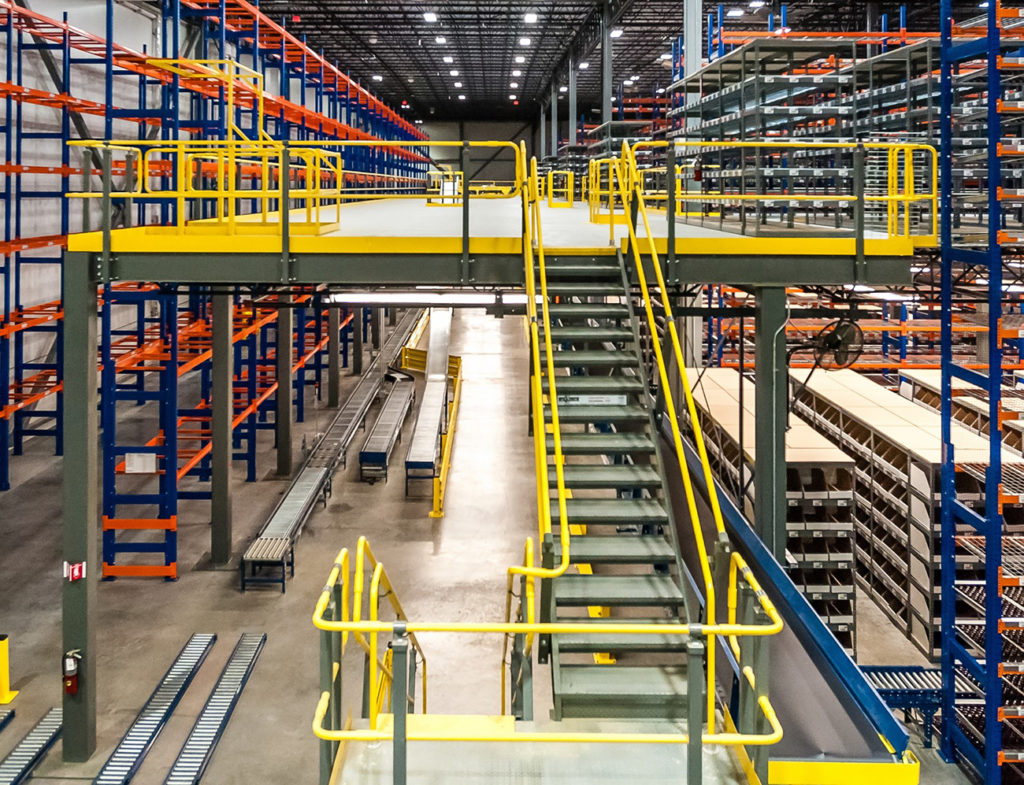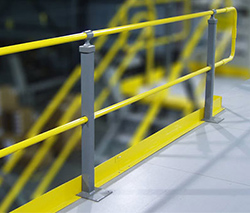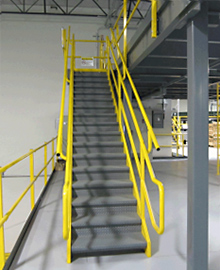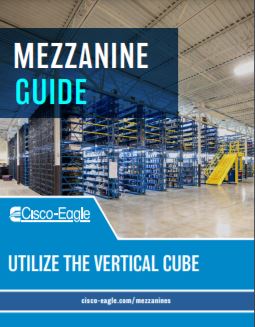Free Falling – Ways To Reduce Mezzanine Falling Items
Protect workers below from potential mezzanine hazards via multiple methods
Mezzanine Safety Products Inquiry Inquiry

Mezzanines offer an affordable way to increase the vertical cube of your facility. This expansion can fuel growth and reduce the need for additional locations (especially in this new normal of sky-high commercial real estate).
When looking at a mezzanine install, or even when operating with an existing version, worker safety is paramount. One safety aspect to pay careful attention to is the risk of falling items from your mezzanine. To help reduce these risks, there are multiple methods of protection available, but which one is the best fit for your mezzanine?
Mezzanine safety options are here to help
As the use of mezzanines is growing among those looking to expand the vertical cube in their facility, so too has the safety enhancements available. With multiple options to help protect your workforce from falling mezzanine items, you want to make sure you’re choosing the right product for your application. Combining certain safety options can ensure an even larger base of protection when it comes to falling items.
What are the causes?
Before we review the solutions, let’s go over what can cause items to fall from a mezzanine area. One of the main components is just exactly what you decide to store and access on the mezzanine, and how you store it. If you place items stacked so high as to reach over the railing on your mezzanine, then that’s a practice that needs to be reviewed by safety for re-allocation. Such dangerous stacking on a mezzanine can definitely increase the chance of a falling item (or items).
How items/product is stored plays a large role, but the movement and mobility allowed in a mezzanine is a big part as well. Aisle widths, maneuverability around the storage methods and worker training are all important factors that need review to form a good plan to help protect workers on the ground.
Guarded solutions
 So in addition to quality safety training and best practices for storage above, adding multiple protection options can keep workers below safe. When considering which safety product is best to apply to your mezzanine, you’ve got to be on guard:
So in addition to quality safety training and best practices for storage above, adding multiple protection options can keep workers below safe. When considering which safety product is best to apply to your mezzanine, you’ve got to be on guard:
Guardrail – The most obvious choice to begin your mezzanine protection is by installing guardrail as the first line of defense. Not to be confused with adding handrail to your structure (although we’ll discuss handrail later), adding guardrail to a mezzanine works to protect both employees below from falling items, but also to keep those working on the second level protection from falling themselves.
When looking to add guardrail to your mezzanine, you’ll want to be aware of current codes and regulations. Deciding whether you need to comply with OSHA, IBC or another code is important and will steer your design and product selection. For example, OSHA regulations require the top edge of a railing to stand 42″ above the walking or working level, plus or minus 3″. IBC also uses 42″ as its height requirement, but it doesn’t allow the same 3″ variance. These subtle differences must be paid attention to comply and keep your workers safe.
Don’t forget the nets!
Adding safety netting to your guardrail will provide even more safety for workers below. When you have inventory that is stored close to the ledge, your guardrail might have too much space in between to adequately keep those items from falling. In order to minimize risk, it is important to install a netting solution that is designed specifically for the application within your warehouse. Think “plugging the gap” so to speak!
Read more: Where to add warehouse guardrail
Kickplates – While railing along a mezzanine is definitely a required line of defense, adding kickplates should also be a high-priority consideration. Your workers below aren’t just in danger of large items (or people!) falling on them, but smaller pieces that can easily roll under a railing. By installing kickplates, you add to an overall high level of protection.
A kickplate is basically a long, solid steel plate that extends upward along the edges of a mezzanine’s surface. Usually around 4 inches high vertically, kickplates provide ample protection for items dropped or mishandled that reach a mezzanine floor. Offered in 2, 4 or 8-inch sections allow easy mix and matching for compatibility and complete coverage along the entire surface of a mezzanine.
Read more: OSHA standards for mezzanines and platforms
 Stairway protection – To even access the areas of your mezzanine that require guardrails and kickplates require your workers to move upward on stairs. These stairs should have their own protective solutions in place to protect workers or items from falling off on the way up! Ensuring your stairway steps follow certain guidelines for height and loading is important, but we want to focus on the right railing you’ll want.
Stairway protection – To even access the areas of your mezzanine that require guardrails and kickplates require your workers to move upward on stairs. These stairs should have their own protective solutions in place to protect workers or items from falling off on the way up! Ensuring your stairway steps follow certain guidelines for height and loading is important, but we want to focus on the right railing you’ll want.
Modular stairway railing options exist to provide an easy solution. You can configure the railing to match your length and height requirements, while also allowing for any expansion needed in the future. To comply with railing standards for stairways, make sure what you install measures between 34 inches and 38 inches in height from the top of each tread. Just as with guardrail at the top, you can also apply safety netting along the stairway for extra protection.
Complete protection from falling mezzanine items would be a combination of some or all of the options discussed. If you need to start with just one, feel free to choose what works best for your application. Each offer a distinct way to keep items on your mezzanine floor from falling, and together they create a barrier for all types of items (or people).
Download our Mezzanine Guide
The space you already have is more valuable than the space you could acquire. Adding a mezzanine to your facility can rapidly increase your vertical space available, and provide added efficiency and long-term value to your operations. Check out our guide for mezzanine specifications, styles, accessories and applications. You will find quick, useful information on mezzanines and how you can use them more effectively.
Download the guide today
Tags: Safety & Ergonomics, Space Optimization
Evan Fleishacker




